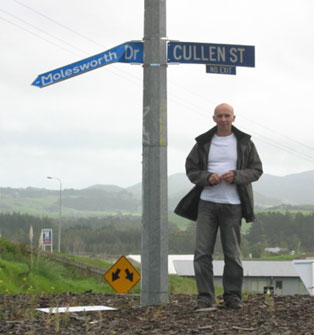John Hurrell – 14 March, 2017
Cullen was highly respected as an exceptionally gifted artist who really didn't get the acknowledgement in this country that his work deserved. With its interest in gardening, science and subverting ‘natural laws', and distinctive mischievous humour, his practice had a European sensibility that undermined the ethos of science while toying with fetishism and the detectable material signifiers of ‘the active intellect'.
After a long debilitating illness, Paul Cullen died last night. If ever there is an obvious truth it is that this man will be greatly missed. A notably gentle and kind (but thoughtful and firm) artist, observant and articulate - whose work was funny and serious - Cullen became first known for his temporary installations of the late seventies and wooden sculptures of the early eighties, the latter being conceptually linked to his (then working) life as a furniture maker, producing for gallery shows distinctive teetering stools with hinged flaps and raw textured edges. Decades later these unstable structures resurfaced in his Formica tables with three legs and counterbalancing devices.
In his later life, Paul was beloved by his pupils and colleagues in his employment as a lecturer at Manukau Institute of Technology and then AUT, affectionately revered as a pedagogical communicator and good listener, and highly respected as an exceptionally gifted artist who really didn’t get the acknowledgement in this country that his work deserved. With its interest in gardening, science and subverting ‘natural laws’, and distinctive mischievous humour, his practice had a European sensibility that undermined the ethos of science while toying with fetishism and the detectable material signifiers of ‘the active intellect’. He was unusual in that he had a BSc as well as a Doctorate in Fine Art.
The show that he did with Allan Smith, Provisional Arrangements, that went to Ilam Campus Gallery in Christchurch and then Two Rooms in Auckland was a superb introduction to Cullen‘s thinking: an excellent synopsis of his preoccupations. Hopefully some municipal institution will organise a much bigger survey to look at the incremental changes in his work over four decades, exploring the different types of indoor and outdoor installation he delighted in, investigating the connotations of normally invisible everyday objects like tables, books, pencils and rules, enjoying his wildly imaginative use of kinetics, and thinking about what it means to observe and hypothesise.
John Hurrell
Here are some thoughts from Andy Thomson, one of Paul’s teaching colleagues at AUT:
Our dear friend and colleague Paul Cullen was one of the most decent and dedicated men we have ever known or worked with. Since arriving at AUT in 2008 from MIT, he led the Sculpture section of Visual Arts, and then later stepped up from our ranks to become an Associate Professor and our Head of Department of Visual Arts (2014-2016). This new role suited him: he was even-handed, measured in his judgments, creative in resolving both day-to-day and those subject-orientated issues and challenges that characterise life and work at art school, but most of all he facilitated collegiality and reinforced our mutual respect for each other, the students and the work of teaching.
As a teacher and fellow artist, Paul’s formidable intellect shaped a presence of mind that could move from a teaching exchange to a collaborative creative decision without skipping a beat - his attention within any context, was always centred on the work, or the issue at hand. A sculptor first and foremost, always practical, always creative, always helpful, Paul was an exemplar at moving things and people forward in terms they could understand and work with. Paul’s art practice was at the centre of everything he knew and loved about the world, and he took the students and us with him in this love and deep knowledge of his subject. His capacity for teaching was endless and he inspired all of his students with a wonderful, studio-centred modus operandi as practicing artists, nurturing and supporting students and graduates both inside and outside of the institution, making opportunities for them whenever and wherever he could. His energy for work - educational and creative, practical and personal, was unparalleled - even in the last stages of his illness he worked extending the practice to new contexts and opportunities for exhibition.
As well as being a deeply intellectual man he was the most skilled, practical and ingenious maker; tools, objects and the material world jumped to his command. The fact that he was a truly gifted and creative artist and lecturer, made it easy for him and us to be part of and deeply respectful towards his new leadership and plans for the future, a future so sadly cut short. Paul was one of the funniest of men, someone who could put a whole room of artists into fits of laughter within seconds and therefore also put them at ease. I’m sure we all remember a recent idyllic summer staff retreat he held in his studio, full of his ongoing and amazing sculptural works, his regaling us with laughter, great ideas and plans for curriculum development. The whole department is in grief and shock today - we have all been missing him greatly this last academic year and also during this new one, but this experience of missing him, in no way prepared us for his untimely death from motor neuron disease on Monday evening.
Arohanui Paul

 Two Rooms presents a program of residencies and projects
Two Rooms presents a program of residencies and projects Advertising in this column
Advertising in this column



This Discussion has 0 comments.
Comment
Participate
Register to Participate.
Sign in
Sign in to an existing account.